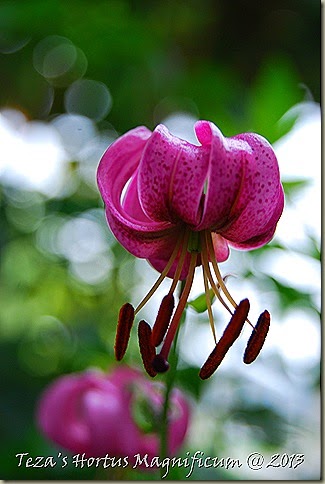
A recent trip to Lost Horizons [click here for posting] solidified my penchant to update the Rare and Unusual Border of Teza’s Garden. A rather robust Heuchera ‘Mocha’ and several Tricyrtis hirta plants were annexed to other sections of the garden to make room for plants such as this!
As a member of the Hydrangeaceae family, Deinanthe is sadly very obscure in cultivation and is generally only found in connoisseur’s collections – not surprising then, that I would first be introduced to this most beautiful of plants at Lost Horizons!
Deinanthe bifida [pictured above] was found and first described in 1863 by Russian botanist Carl John Maximowicz , who came across it growing in the southern woodlands of Japan. As its specific epithet implies, the species bears leaves that terminate into two distinct, pointed lobes, [ bifid] are approximately 20cm in length and are a rich green, with a slightly leathery texture.. Terminal clusters of nodding, waxy white flowers are held by ghostly pedicels, slightly above the foliage on stems to 45cm. As with some Hydrangea inflorescences, some of the florets along the outer perimeter of the inflorescence are completely sterile and are simply there to attract pollinators towards the fertile flowers towards the centre.
I hesitated in bringing home the crown jewel of the genera, its Chinese counterpart, Deinanthe caerulea, if only because I need to find a larger space for it. It was first discovered by Irish physician Augustine Henry in Hubei Province. It is an exquisite woodland plant and is truly a ‘Holy Grail’ selection, sought after by true woodland plant enthusiasts and connoisseurs like myself. Here is how plantsman Daniel Hinkley describes it in his tome ‘The Explorer’s Garden: Rare and Unusual Perennials’: ‘The leaves, rich green and coriaceous, are produced in pairs along 30-40cm stems that terminate in lovely clusters of nodding, lilac suffused flowers, each with a gorgeous assemblage of lavender-grey stamens crowded inside. Like the shy demure blossom of so many within the genus Helleborus, it requires those wishing to admire the blossom, to either bend or kneel to truly appreciate its beauty! Note to self: Continue the ‘annexation’ of more readily available plants to make room for this ‘Holy Grail’ addition as soon as possible!
Both members of this delightful genus are considered perfectly hardy in Zones 4-8. Successful cultivation requires a shaded position with adequately moist, rich endaphic environments. Too much sun results in burnt and blemished foliage. Propagation can be exasperatingly slow. Inspection of even the smallest clumps, dug in late winter will reveal large numbers of dormant buds that will not break into growth unless removed and planted independently.

































No comments:
Post a Comment